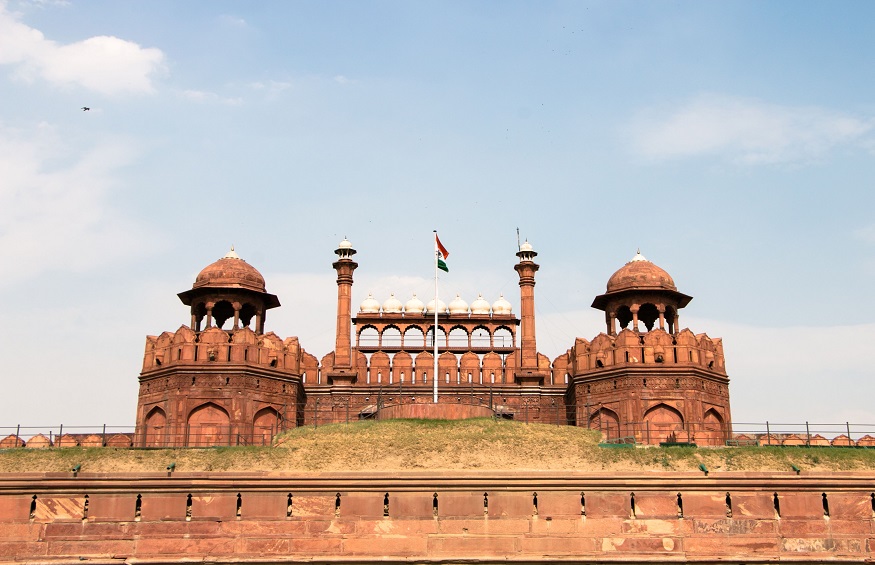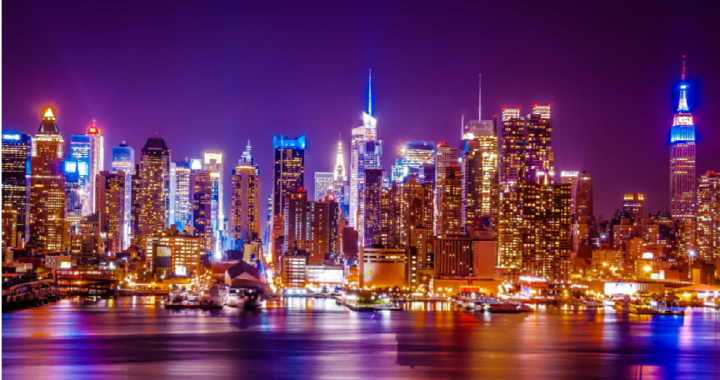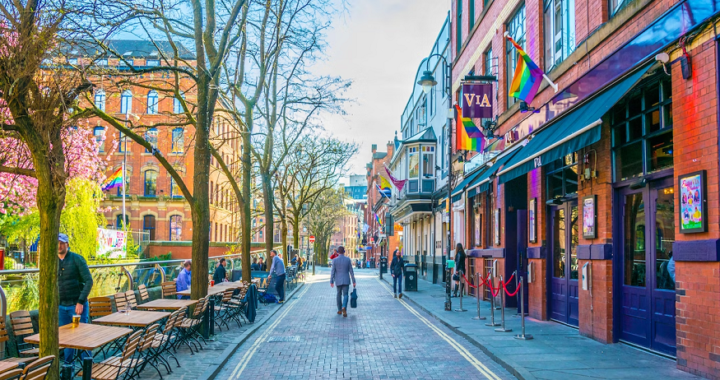8 Must-Visit Attractions in Delhi

Delhi consists of two parts; New Delhi and Old Delhi in which New Delhi serves as the capital of India. New Delhi was ruled as a British Colony till 1931 and gained its independence while Old Delhi has managed to keep its ancient glory over the years. As there are two parts there are plenty of attractions to see in Delhi and activities for you to enjoy. But to make your visit easier, below I have listed the 8 must-visit attractions on your trip to Delhi. This includes historical monuments, museums, temples, famous markets and impressive architectural work.
1. The Red Fort
The Red Fort is a beautiful sight in the city of Delhi. It was the main residence of Mughal Emperors until 1857. Emperor Shah Jahan was the person who commenced the building of the Red Fort in 1638 when he decided to move the capital to Delhi from Agra. The Red Fort was inspired by the favourite colours of Shah Jahan; red and white. It was designed by the same architect, Ustad Ahmad Lahori, who also designed the world-famous Taj Mahal. The architecture in the Red Fort is pretty impressive considering the red sandstone walls built to support the octagonal shape of the entire building. It was originally started with the Islamic architecture but as of now, you can see a blend of Persian, European, Timurid and Hindu architectural styles within the fort. The main gate of entrance, the Lahore Gate is also impressive just like the fort complex and gets its name as it faces Lahore of Pakistan. Entering through the Lahore Gate you will be met up with the Chhatta Chowk, a busy bazaar selling jewellery, silk, gems and other items for you to take back home from your Delhi trip.
Read more: Enjoy an exhilarating journey at desert safari Dubai
2. Qutub Minar
The Qutub Minar is the tallest minaret in India and it is a “victory tower” that forms a part of the Qutub complex, a UNESCO World Heritage Site in Delhi. This eye-catching tower was completed in the 12th century and at the time it measured to a height of 73-metres with its four sections. A fifth section was added in 1369, only to be used today as an observation deck to witness the panoramic views across the city of Delhi. The Qutub Minar was built with different kinds of stones. The first three sections were built with red sandstone, the fourth and fifth sections were built with marble and sandstone. It also has a mosque at the base of the tower built in 1310 named the Quwwat-ul-Islam Masjid entombing the graves of Altamish, Alauddin Khalji, and Imam Zamin.
3. India Gate
Looking just like the Arc de Triomphe in Paris, India Gate is a war memorial located in Delhi to remember the Indian British soldiers that died in WWI. Its pillars are inscribed with the names of 70,000 such soldiers who died between 1914–1921 in different parts of the world; France, East Africa, Afghanistan, Persia and so on. India Gate was designed by Sir Edwin Lutyens, who is a famous architect on designing war memorials and therefore, it resembles the architectural styles of the Arch of Constantine in Rome and the Gateway of India in Mumbai as well. To experience the real beauty of India Gate you should consider visiting it at night when the surrounding fountains are vibrant and the arch is lit with various colours, mostly resembling the colours of the Indian flag.
4. Gurudwara Bangla Sahib
Gurudwara Bangla Sahib, which is another must-visit attraction in Delhi is an important place of worship for people practising Sikhism in India. Gurdwara Bangla Sahib of the 17th century was originally a bungalow belonging to the Indian ruler Raja Jai Singh. However, it became famous when the eighth Sikh Guru, Guru Har Krishan who lived here during the smallpox and cholera epidemic in 1664, started to help the sick people by giving food and fresh water from the well at the bungalow. He too died after being sick the same year and later a tank was built in his place by Raja Jai Singh. The water of this tank is said to be having healing properties and is visited by Sikhs all over the world in times of sickness. Highlights of this bungalow are the water tank, Gurdwara and its Sarovar, the art gallery and the museum which displays the history of Sikh religion.
5. The Lotus Temple
The Lotus Temple, shaped like an actual lotus flower is a Baháʼí House of Worship meaning that it can be visited by people practising any religion irrespective of the sex and the background. The lotus temple is the most visited attraction in Delhi but it does not have a long history like the other tourist attractions in India. It is a unique masterpiece made out of white marble and the constructions began in the 1980s. The lotus temple was constructed according to the architectural formations of Baháʼí Houses of Worship with 27 free-standing marble-clad petals arranged in clusters of three to form nine sides. This rule for the construction was put forth by Abdu’l-Bahá, the son of the founder of this particular religious practice. The nine sides have nine doors opening up to a gigantic central hall. This central hall can hold more than 2000 visitors at a time. But the most notable characteristics of this temple is the absence of statues, images, pulpits and altars unlike the other temples in the world. Also, a glance at the nine ponds in the vicinity and the temple itself will get you the impression of the lotus flower being ready to go in full bloom.
Read more: How to choose your destination and organize your trip?
6. New Delhi National Museum
New Delhi National Museum is one of the largest museums in India established in 1949. The artwork here dates back to the prehistoric times up to the modern-day. Although there are about 2000 artworks in the New Delhi National museum, only a few are on display to the public with over more than 15 galleries. The highlights of the galleries are terracotta sculptures, stone sculptures, bronze sculptures, decorative arts, jewellery, armoury, textiles, and Tanjore paintings. The most significant gallery is the Central Asian Gallery which has a collection excavated by one of the famous archaeological explorers in the 20th century named Sir Aurel Stein. Three expeditions were carried out by him in the 1900s where he collected various cultural materials from ancient Asian cities in the Silk Route; silk textiles, silk banners, wood sculptures, beautiful wall paintings, terracotta coins, porcelain items, pottery, gold and silver items.
7. Jama Masjid
Jama Masjid of Delhi, which is also known by the names Masjid-i Jehan Numa and “Mosque of the Celestial Sphere”, is one of the most beautiful and largest mosques in India. That reason alone makes it a must-visit attraction in Delhi. It was built by the Mughal Emperor Shah Jahan in the 1650s with a mixture of limestone and marble. The mosque has two 40-metre tall minarets again with the favourite colours of Emperor Shah Jehan; red and white meaning that the minarets are constructed out of red sandstone and white marble. The two minarets consist of five storeys and each minaret has a protruding balcony. There are three gates to the mosque- the northern gate has 39 steps, the southern gate has 33 steps and the eastern gate which is the main entrance has 35 steps. The highlights of the Jama Masjid of Delhi is displayed in the northern gate as it contains a Quran written on deerskin, a red beard-hair of the prophet Mohammed, his sandals and his footprints imprinted in a marble block. The prayer hall, on the other hand, has marble domes and non-Muslims are not allowed to be inside it during the prayers. Also, you should remember to dress covering yourself properly when visiting the Jama Masjid of Delhi.
8. Humayun’s Tomb
Set up in a lovely green lawn is the Humayun’s tomb, the tomb of the Mughal Emperor Humayun of Delhi in India. It was built under the instructions of his first wife, Empress Bega Begum and was designed by two Persian architects, Mirak Mirza Ghiyas and his son, Sayyid Muhammad. It was the first monument to be built with red sandstone on such a scale in India. Therefore, it was also declared a UNESCO World Heritage Site by the Indian government. The Humayun’s Tomb is close to the style of the Taj Mahal in Agra and displays impressive Mughal architecture. The tomb reaches a height of 47 meters and has a double dome on it. The exterior parts of the dome are made of white marble while the rest of the building is made mostly of red sandstone. The burial chamber of the Emperor Humayun is under this white marble dome. It is placed according to the Islamic tradition; aligned on the north-south axis, the head is placed to the north and the face turns sideways towards Mecca. But this is not the real burial chamber and it is placed further away from this site in an underground chamber which is not accessible to the public.

 Ibiza Yacht Retreat: Rejuvenate Your Mind, Body, and Soul
Ibiza Yacht Retreat: Rejuvenate Your Mind, Body, and Soul  Best Places to Stay in Bangalore below 15000
Best Places to Stay in Bangalore below 15000  Legal Considerations for Traveling and Living Abroad
Legal Considerations for Traveling and Living Abroad  When and why should travel Dubai from CHENNAI
When and why should travel Dubai from CHENNAI  Alkhail Transport’s Luxury Vans: Where Luxury Meets Convenience
Alkhail Transport’s Luxury Vans: Where Luxury Meets Convenience  Things You Need To Know Before Travelling To Manchester
Things You Need To Know Before Travelling To Manchester  Epic Journeys to Everest: Discover the Region’s Four Iconic Treks
Epic Journeys to Everest: Discover the Region’s Four Iconic Treks  What You Need to Know About Teahouse Trekking on the Everest Base Camp Route with Sherpa Expedition
What You Need to Know About Teahouse Trekking on the Everest Base Camp Route with Sherpa Expedition  Discover the Wonders of Italy with Tailored Italy Tour Packages
Discover the Wonders of Italy with Tailored Italy Tour Packages